These are the best fluffy vegan mashed potatoes! Soaking and rinsing the potatoes prior to cooking and use of a potato ricer will ensure that ultra fluffy, yet smooth texture. Steaming the potatoes, meanwhile, helps to lock in flavor. If you don’t have a potato ricer, don’t worry: this post gives an alternative, along with other tips and tricks for creating a perfect, versatile batch of vegan mashed potatoes at home.
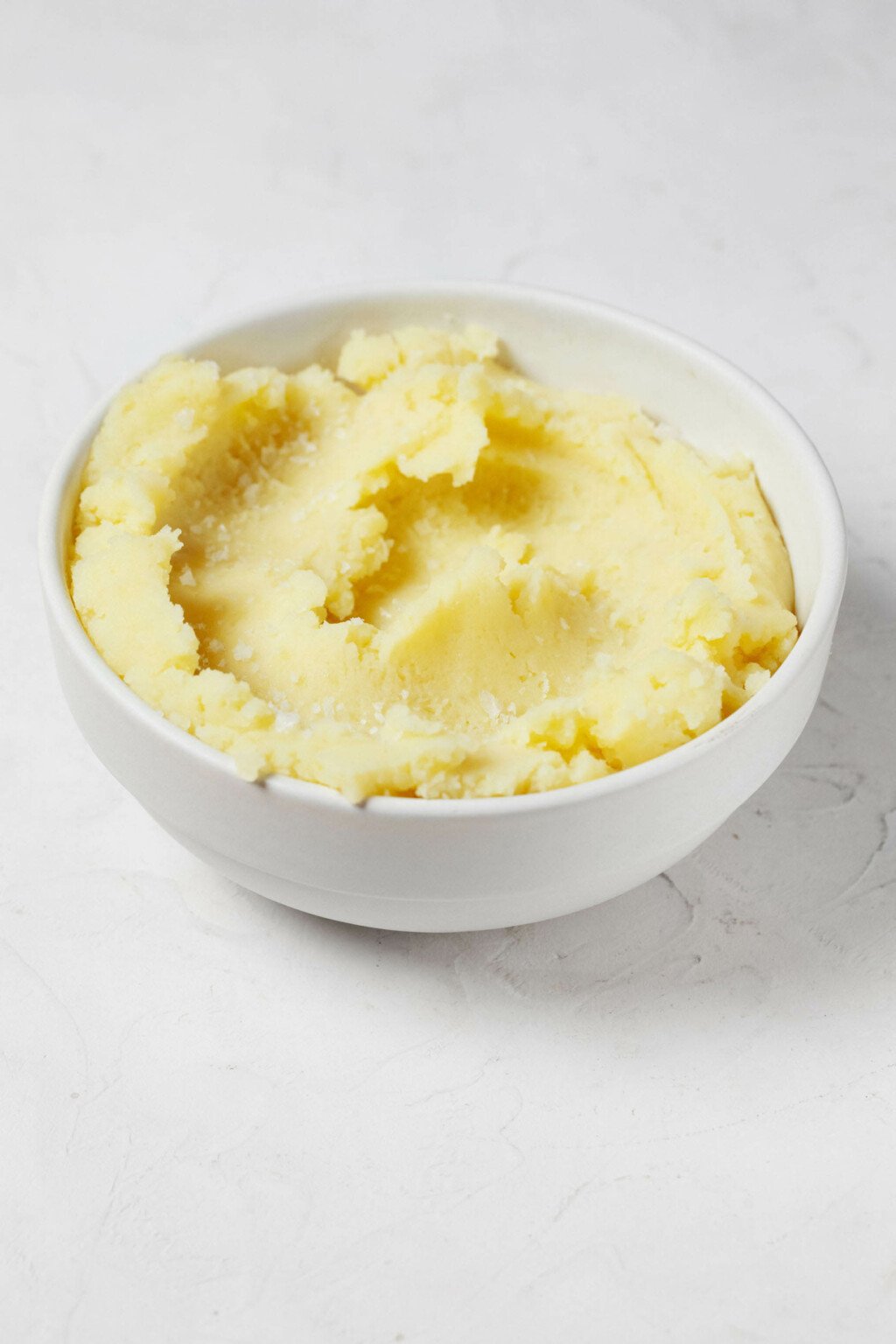
There’s just nothing like a heap of warm, fluffy mashed potatoes.
For years, my mom and I would debate holiday side dishes.
I would insist that mashed potatoes—her favorite—were sort of boring. I preferred candied sweet potatoes, sweet potato casserole, or the Greek lemon roasted potato wedges of my childhood.
Or so I thought.
It’s really only in the past five years that I’ve come to embrace classic, traditional mashed potatoes as the delight that they are.
Today, I want to share the recipe that has become my only recipe for vegan mashed potatoes.
I love it because it’s cozy and comforting and buttery, as mashed potatoes should be. But I especially love its texture.
The science of spuds
It’s impossible to write about perfecting mashed potatoes without getting a little bit technical about potatoes.
Have you ever wondered what the word “starch” actually means? It can be used to denote a carbohydrate, or even used interchangeably with the word “carbohydrate.” I myself swap these terms often.
As a registered dietitian, I probably ought to be more precise. Starch is a type of carbohydrate. It’s a complex carbohydrate, or polysaccharide, made from chains of glucose, which is a type of sugar.
There are two primary forms of starch, amylose and amylopectin. Amylose consists of linear chains of glucose, while amylopectin is made of branched chains.
Foods that contain starch, potatoes included, will have different proportions of amylose versus amylopectin.
Russet potatoes, which are my first choice for mashing, contain a higher proportion of amylose to amylopectin than so-called waxy potatoes, like red-skinned potatoes, fingerlings, or new potatoes.
Amylose breaks down the the presence of water. As a result, russet potatoes can crumble, break apart, and become light and fluffy through mashing.
Waxier potatoes, by contrast, tend to resist this process, resulting in mashed potatoes that may seem gluey or dense.
Here’s the rub: in the presence of water, amylose will break down into starch granules that absorb liquid.
This is a good thing to some extent. It means that russet potatoes can soak up the melted butter and milk that make mashed potatoes so delicious.
The double-edge sword is that starch granules tend to burst, releasing starch molecules into the mashed potatoes (or any other type of food).
Too much starch will result in potatoes that are, for lack of a better word, starchy.
If super light and fluffy mashed potatoes are the goal, then preparing them is a matter of managing how much starch ends up in the finished product.
Three key steps in making fluffy vegan mashed potatoes
How does one take advantage of the naturally occurring amylose in potatoes without risking mashed potatoes that are overly starchy and water-logged?
There are three tricks that have helped me.
Tip 1: Soak your potatoes in cold water prior to cooking
Cold water will act like a magnetic environment for the starch in your cubed russets.
When you soak and rinse the potatoes prior to cooking, you’ll immediate remove some excess starch from them.
As a result, your mashed potatoes will be lighter and less starchy than they would be otherwise.
Tip 2: Steam your potatoes, rather than boiling them
Because starch granules absorb water so readily, russet potatoes tend to get waterlogged when they’re boiled or simmered.
At this point, the potatoes will have absorbed so much water that they can no longer absorb much flavor.
If you want your cooked potatoes to easily absorb melted vegan butter, plant milk, and seasonings—or if you simply want your potatoes to taste more like themselves—try steaming them prior to mashing and seasoning.
I think this step is a game changer, and it’s the only way that I make mashed potatoes now.
Tip 3: Use a ricer
A potato ricer is a beautiful thing.
This humble, not-too-spendy kitchen gadget will break down your potatoes into tiny, rice-sized parcels.
It works with the starchy, crumbly texture of russets, resulting in a light and fluffy potato mixture that can then be easily transformed into a light and fluffy mash.
Once you’ve riced your potatoes, you need only add your seasonings—mine are melted vegan butter, unsweetened plant milk, salt, pepper, and sometimes a pinch of garlic or onion powder—and use a spatula to fold them together.
A few turns of the wrist with the spatula ought to yield beautifully light and fluffy mashed potatoes.
Which potato ricer do you recommend?
Honestly? Almost any ricer will do.
I have an OXO potato ricer that’s great, but it doesn’t need to be as sleekly designed as it is. Potato ricers have one central function, and you don’t need a fancy model in order to have great results.
What else can I do with a potato ricer, if I buy one?
Of course, if you invest in any appliance, you ought to be able to take full advantage of it.
You can definitely use your potato ricer in more than one way. Here’s a list of other culinary purposes that it will be great for:
- Making homemade baby food or vegetable/fruit purées
- Making applesauce
- Wringing moisture out of defrosted and cooked frozen spinach (for example, if you want to make my vegan spinach lasagna rolls)
- Skinning and mashing cooked beans (for example, if you want a finely textured batch of smashed chickpea or smashed white bean salad)
- Mashing bananas for vegan banana bread
How to make super fluffy vegan mashed potatoes
Now that we’ve gone over the science, let’s get to the fun part: making mashed potatoes!
Step 1: Soak and rinse the potatoes
In this first step, you’ll be removing excess starch from your spuds.
Fill a large bowl of water with cold water and add your cubed potatoes. Stir them around in the water a bit, allowing the water to become cloudy in appearance.
Next, drain the potatoes and rinse them off. Repeat this process 2-3 times, until the cold soaking water is clear, then drain and rinse the potatoes one final time.
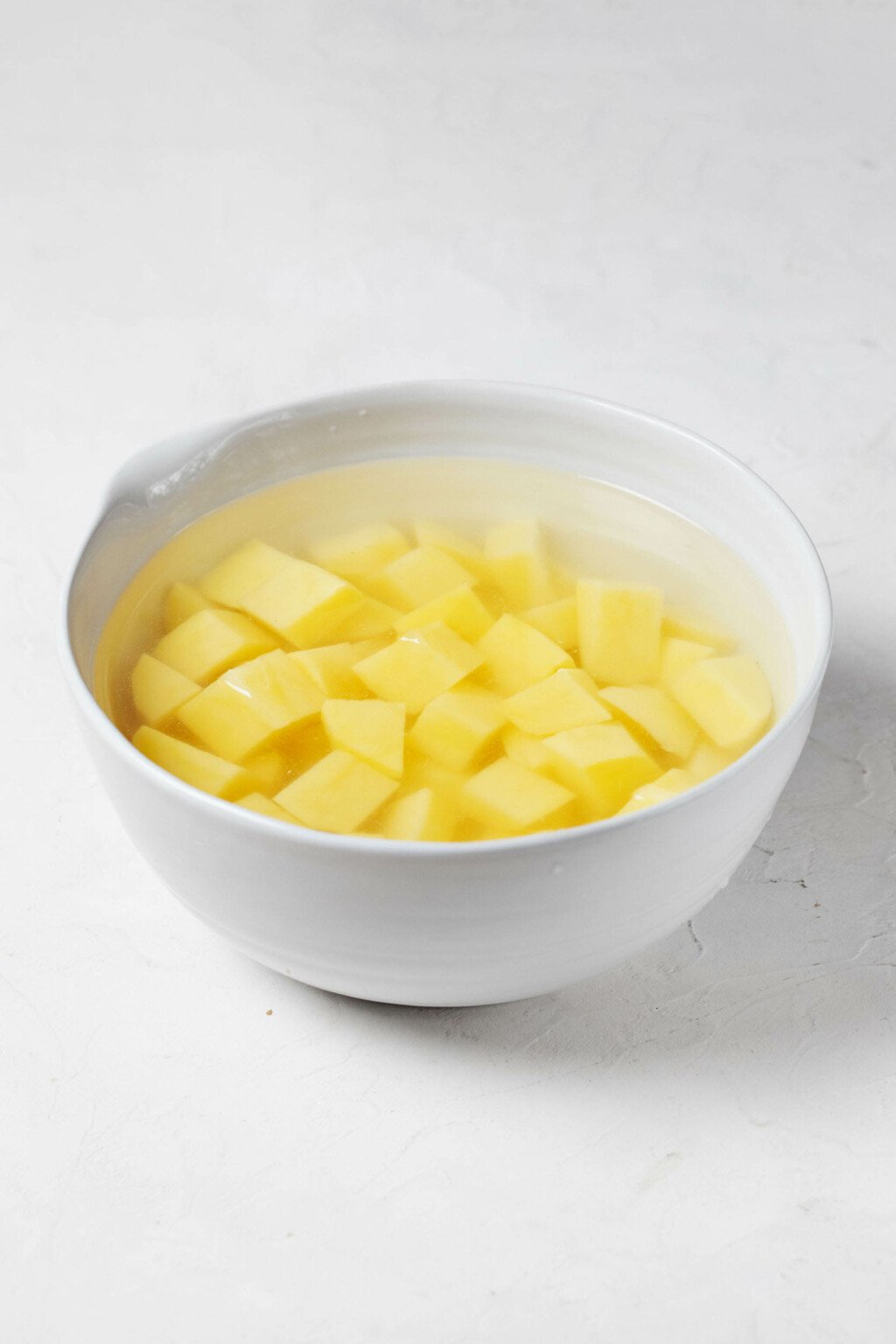
I know this seems like a lot of fuss, but I promise, it’s a worthwhile step.
Step 2: Steam the potatoes
Next, you’ll steam the potatoes till they’re very fork-tender. This ought to take 20-25 minutes.
Step 3: Rice the potatoes
Place the warm pot that you used for steaming the potatoes onto a flat surface. Use your ricer to rice the potatoes into the pot.
If you don’t have a ricer at home, you can return all of the potatoes to the pot, then use a handheld potato masher to mash them up.
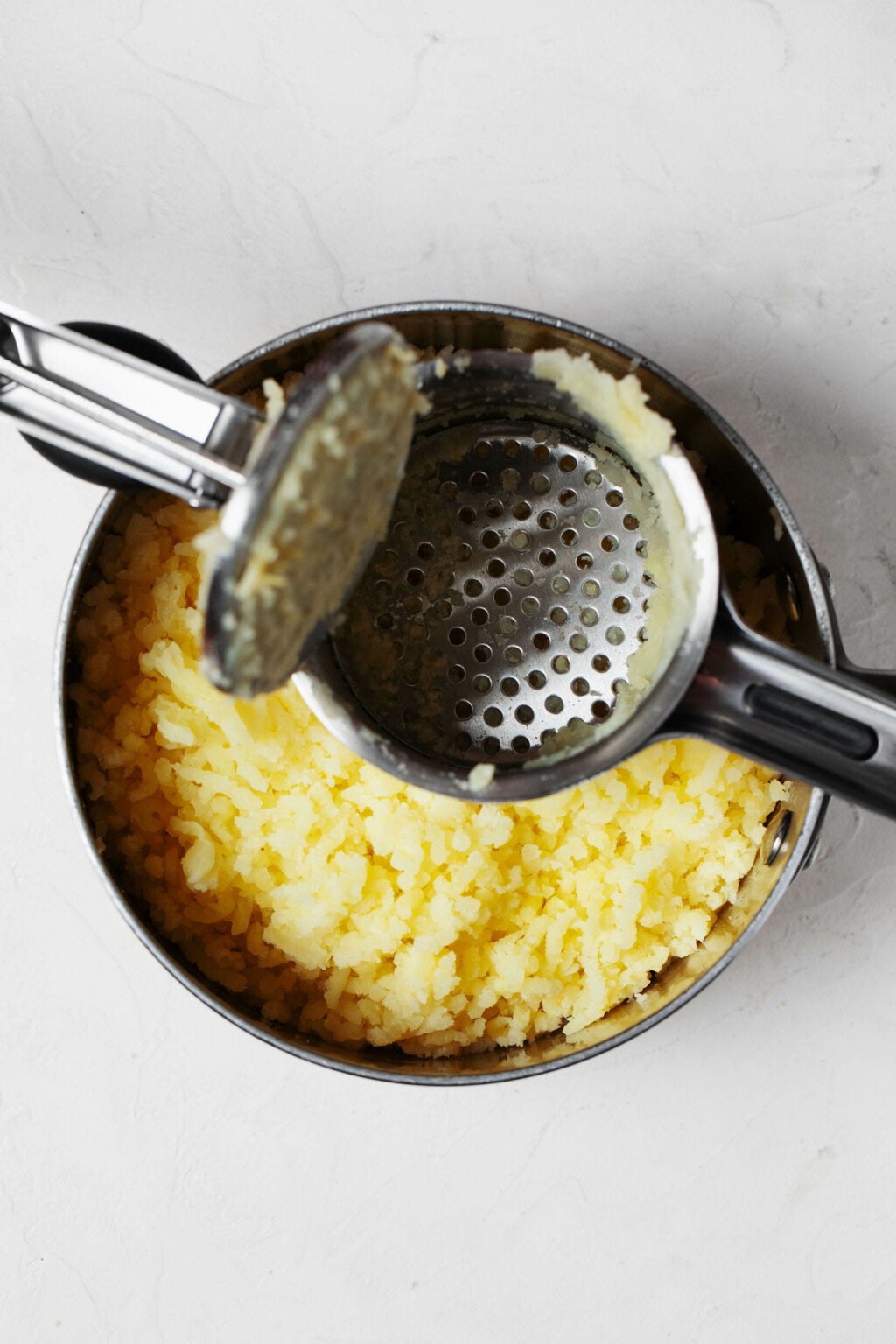
Step 4: Add the seasonings
Next, you’ll add melted vegan butter, warm non-dairy milk, and salt to the potatoes.
I like to add my milk and butter to a microwave-safe, Pyrex liquid measuring cup, then warm them in the microwave. However, you can easily add both to a small saucepan and warm them until the butter is melted and the milk is just below a simmer.
Pour the liquids into the mashed potatoes and fold everything together with a spatula. Try to have a light touch as you do this; you don’t want to over-handle the potatoes.
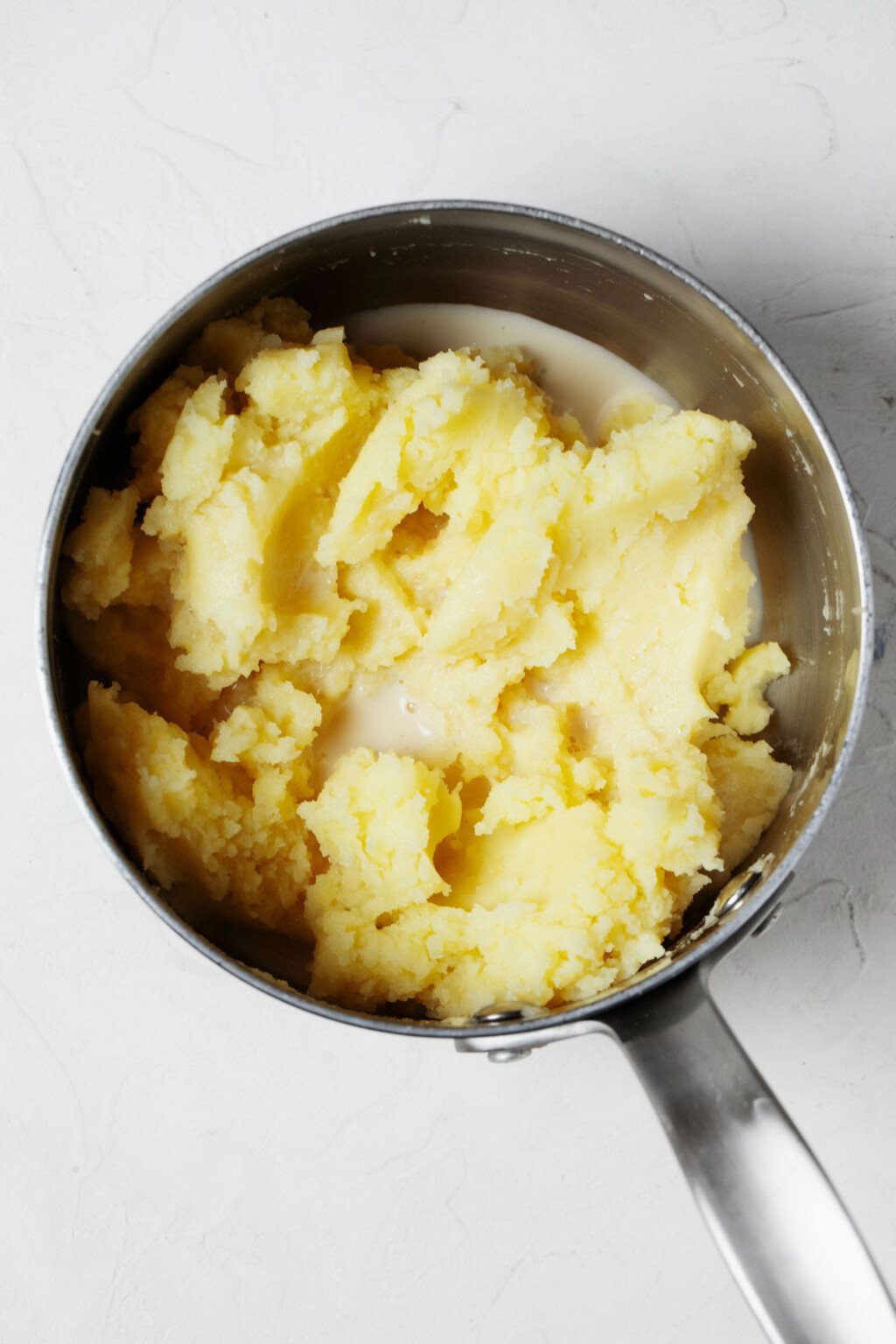
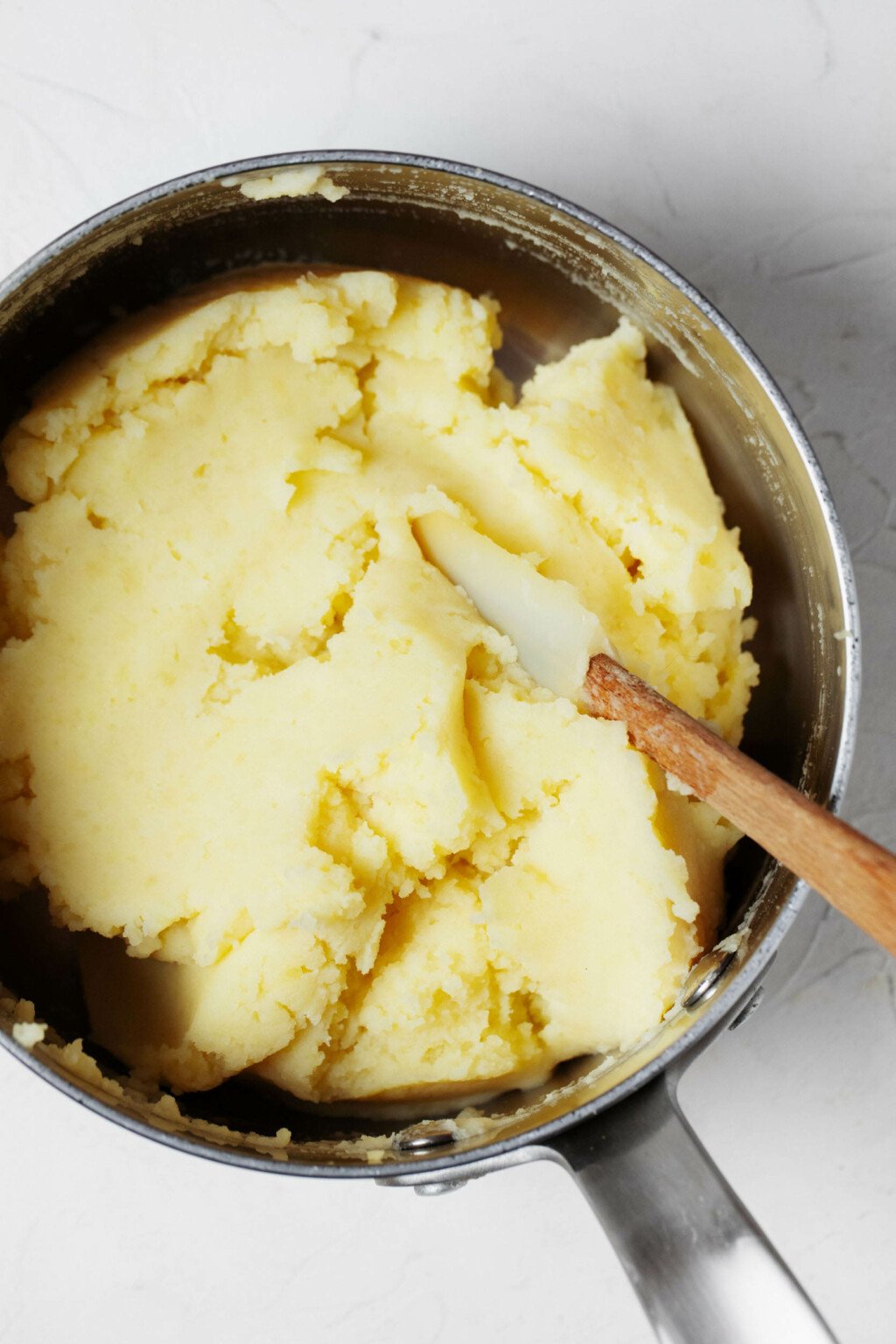
Add additional milk as needed, until you achieve a fluffy, smooth texture that you’re happy with. Taste the potatoes and add any additional salt you’d like, along with freshly ground black pepper to taste.
Step 5: Serve
I love vegan mashed potatoes just as they are and typically don’t add any garnishes.
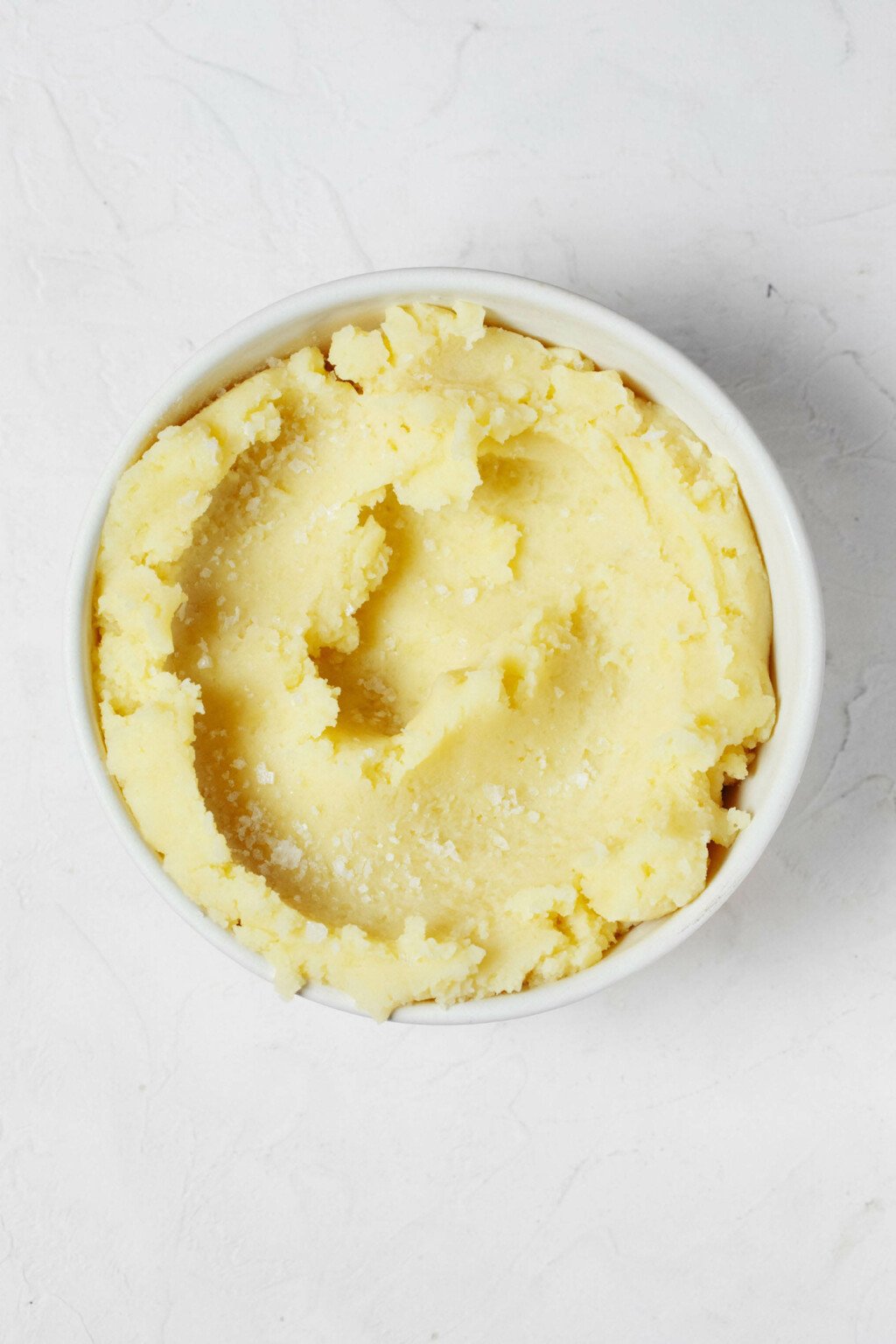
However, a sprinkle of snipped chives or chopped parsley leaves can be a really nice touch, if you have either in the fridge.
I also love to add some flakes of Maldon or an extra turn of freshly ground black pepper.
If you’d like to add a touch of richness to your potatoes, try a dollop of all-purpose cashew cream on top.
Meal prep & storage
There’s no denying that these mashed potatoes are at their peak when they’ve just been prepared. But what if you need to make them ahead of time?
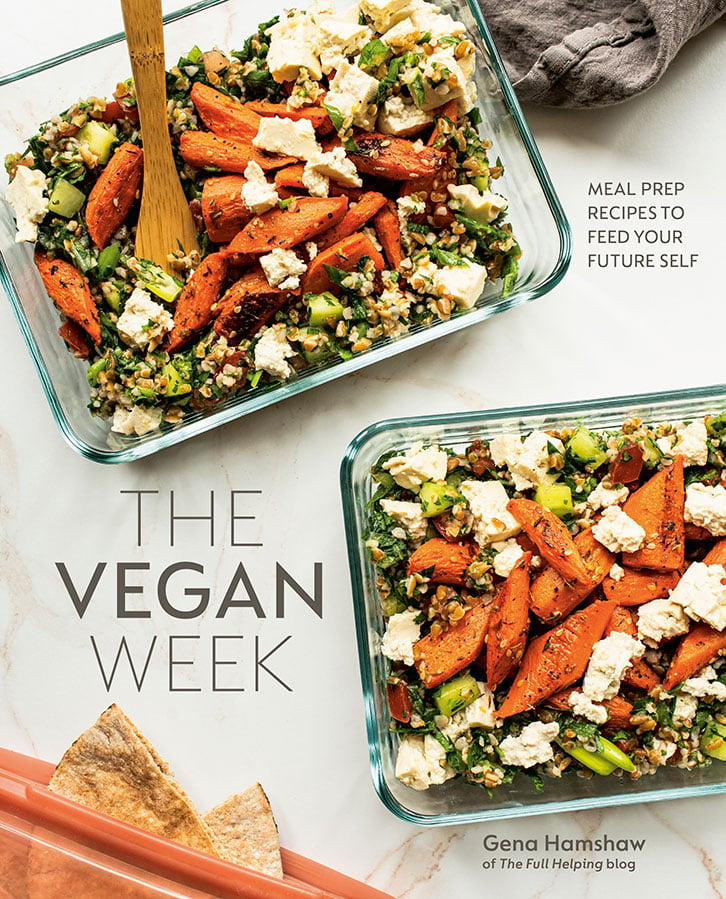
The Vegan Week
Embrace the joy of eating homemade food every day with the hearty and wholesome recipes in The Vegan Week.
Whether you have three, two, or even just one hour of time to spare, The Vegan Week will show you how to batch cook varied, colorful, and comforting dishes over the weekend.
Because I often make my vegan mashed potatoes for holiday gatherings, I’m actually used to preparing them a day or two before serving.
Mashed potato storage
Mashed potatoes should be stored in an airtight container in the fridge. They’ll keep for up to four days this way.
If you’d like to freeze the potatoes, you can do so for up to 8 weeks. This can be done in a single airtight storage container.
For individual portions, you can try a muffin tin or using an ice cream scoop to freeze mounds of potato on a sheet pan (like so).
Holding or reheating mashed potatoes
If you need to reheat or keep mashed potatoes warm, there are a few options.
Option 1 (short amount of time): cover
If you only need to keep freshly prepared mashed potatoes warm for only a short period of time—say, 15-20 minutes—you can simply cover them with a damp tea towel or silicone lid and let them be.
Option 2: oven
You can easily reheat mashed potatoes in a 350°F / 175°C oven. I recommend doing this in an oven-safe baking dish with foil as covering.
Before you transfer the potatoes to the oven, add some additional non-dairy milk and a pat or two of vegan butter to the top of the potatoes. After 20-30 minutes in the oven, uncover the potatoes and stir them gently.
Option 3: Stovetop
If you have only a small portion of potatoes to reheat, you can try warming them in a small saucepan. As with the oven option, be sure to add some extra non-dairy milk and/or butter to help loosen the cold potatoes.
Option 4: Slow cooker
The folks at The Kitchn taught me that you can also heat up leftover vegan mashed potatoes in your slow cooker, if you have one.
Add your batch of mashed potatoes to the slow cooker, then add a generous amount of non-dairy milk and at least two tablespoons of melted vegan butter.
Heat the potatoes on the low setting for up to 4 hours, stirring once each hour.
What type of vegan butter do you use?
For this recipe, you can use any vegan butter of choice. Butter for mashed potatoes is unlike butter for pastry-making in that flavor, rather than performance, matters most.
So, choose a vegan butter that has a taste you love. I usually use Earth Balance at home, but I also love Wayfair butter and Om Sweet Home, a local-to-me brand.
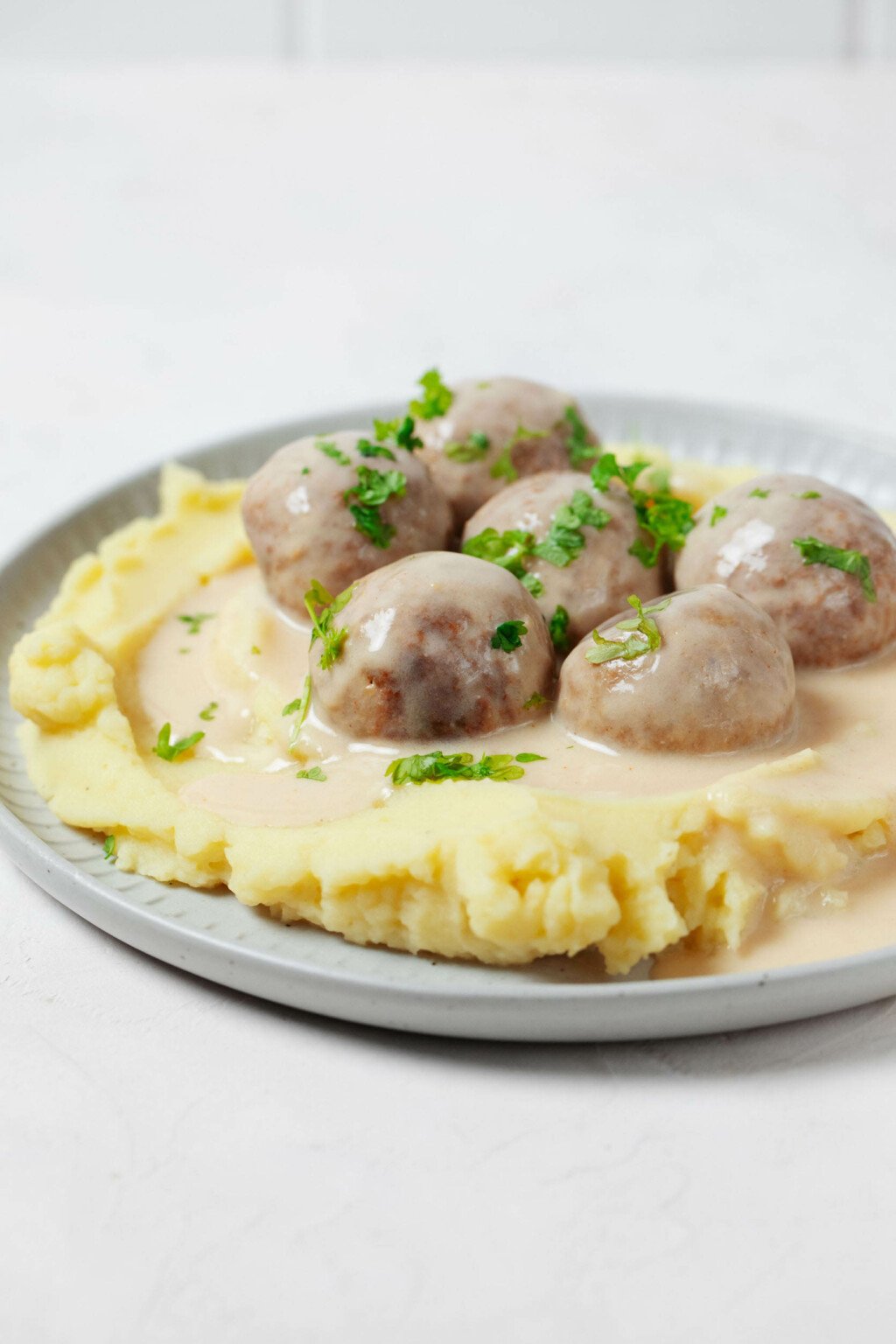
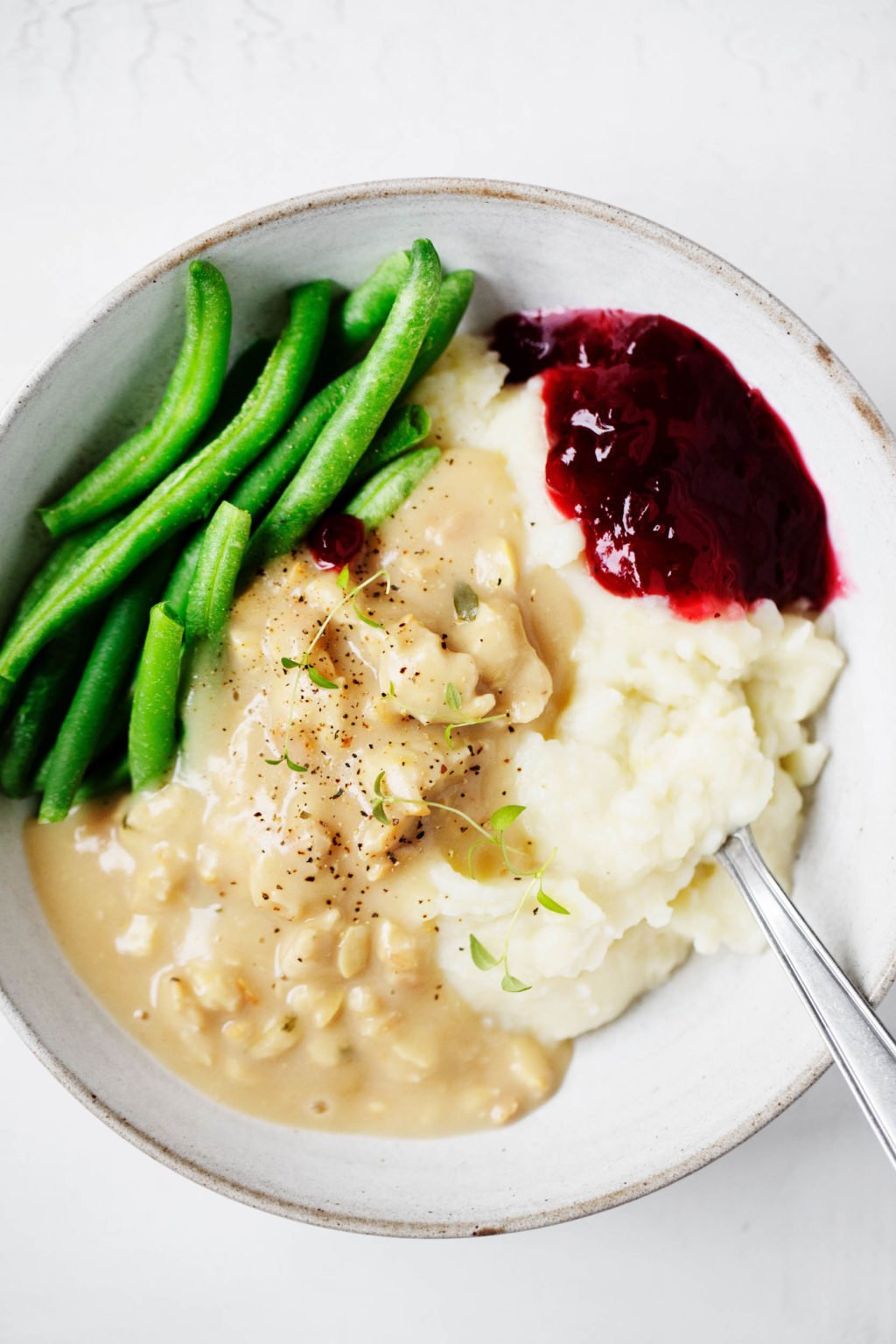
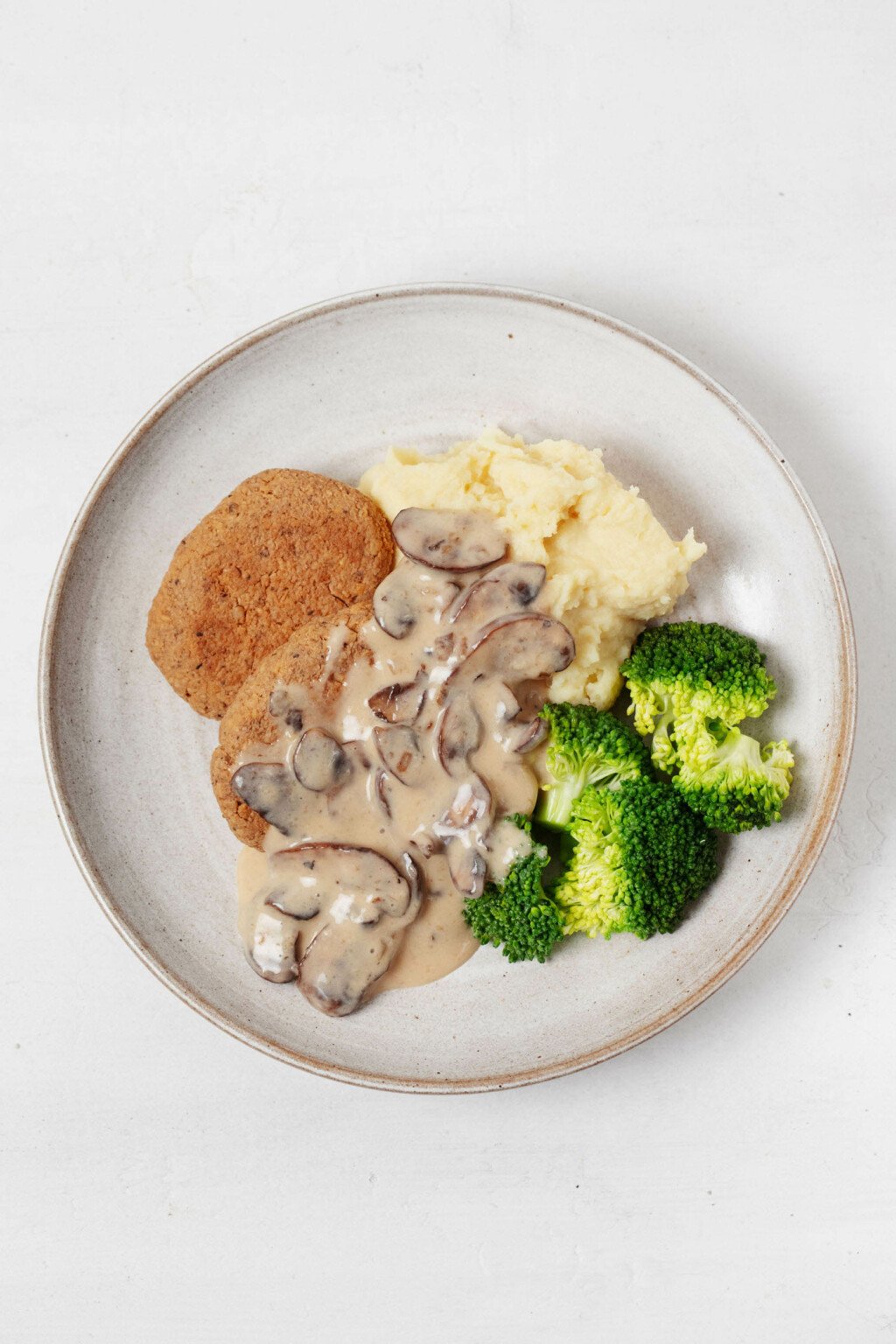
How to serve vegan mashed potatoes
Essentially, you can serve these mashed potatoes however you’d typically serve mashed potatoes. They can be a side dish or the foundation of a meal.
Here are some of my recipes that use or showcase mashed potatoes:
- Vegan vegetable mushroom shepherd’s pie
- Mashed potato bowls with savory tempeh gravy
- Vegan Swedish meatballs
- Creamy chickpeas & mashed potatoes
- Vegan Salisbury “steak” with mushroom gravy
And here is my much-loved vegan mashed potato recipe. I’m grateful to Genevieve Ko and J. Kenji López-Alt for having inspired and educated me as I was on the way to a forever formula!
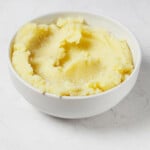
Perfectly Fluffy Vegan Mashed Potatoes
Author –Ingredients
- 3 pounds russet potatoes, peeled and cut into 1-2 inch / 2.5-5cm chunks (1.4kg)
- 6 tablespoons vegan butter (85g)
- 3/4 cup unsweetened soy, oat, or cashew milk, plus extra milk as needed (180ml)
- 1 teaspoon kosher salt (more as needed)
- Freshly ground black pepper, to taste
Instructions
- Fill a large pot with a few inches of water and fit it with a steamer attachment. Bring the water to a simmer, then turn the heat to medium low.
- In the meantime, fill a large bowl of water with cold water and add the potatoes. Use your hands to stir them around in the water, allowing the water to become cloudy in appearance. Drain the potatoes and repeat this process 2-3 times, until the cold soaking water is clear. Drain and rinse the potatoes again.
- Transfer the potatoes to the steamer. Steam them for 15-20 minutes, or until all of the chunks are very fork-tender. Remove the steamer from the pot and drain the pot of water.
- Transfer the empty pot to a flat surface. Use a potato ricer to rice the potatoes into the empty pot. This is the best method for very fluffy potatoes, but if you don't have a ricer, you can transfer the potato chunks to the empty pot and mash them with a handheld potato masher.
- Place the non-dairy milk and butter into a microwave-safe Pyrex liquid measuring cup and microwave for 1 minute, or until the milk is warm and the butter has melted. Alternatively, warm and melt the ingredients together in a small saucepan on the stovetop.
- Add the warm liquid and salt to the pot. Use a spatula to gently fold and mix the seasonings into the potatoes. Add additional milk as needed, until you achieve a fluffy, creamy mashed potato consistency that's to your liking; this may require an additional 1/4-3/4 cup / 60-180ml of milk.
- Taste the mashed potatoes and add additional salt and pepper as needed. Serve.
Notes
It just so happens to be an especially chilly day where I am, so I couldn’t be more in the mood for a warm batch of mashed potatoes. I may need to whip one up as soon as I publish this post.
Hope you’ll fall in love with the texture and flavor of this versatile recipe, too.
xo
This post may contain affiliate links. If you use these links to buy something I may earn a commission. Visit my privacy policy to learn more.
Method: Stovetop
Ingredients: Potatoes
Dietary Preferences: Gluten Free, Soy Free, Tree Nut Free, Vegan


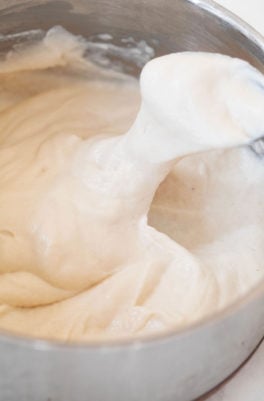
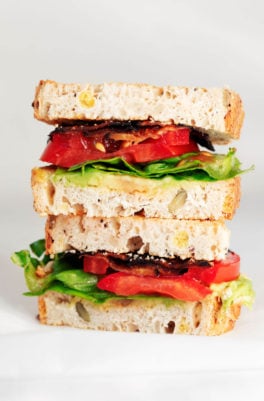
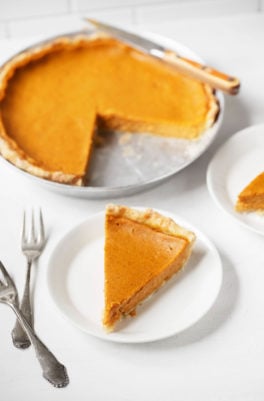
Leave a Comment